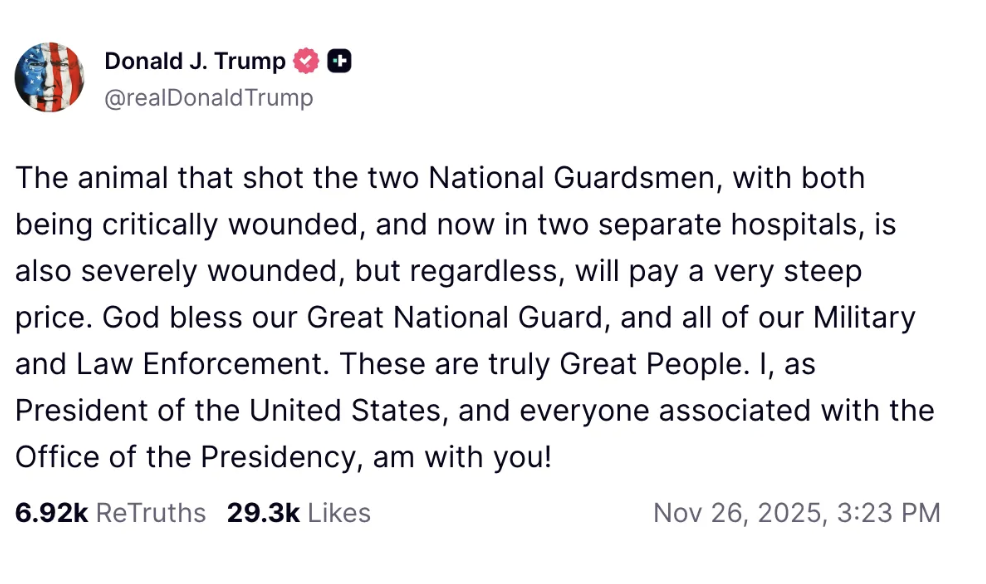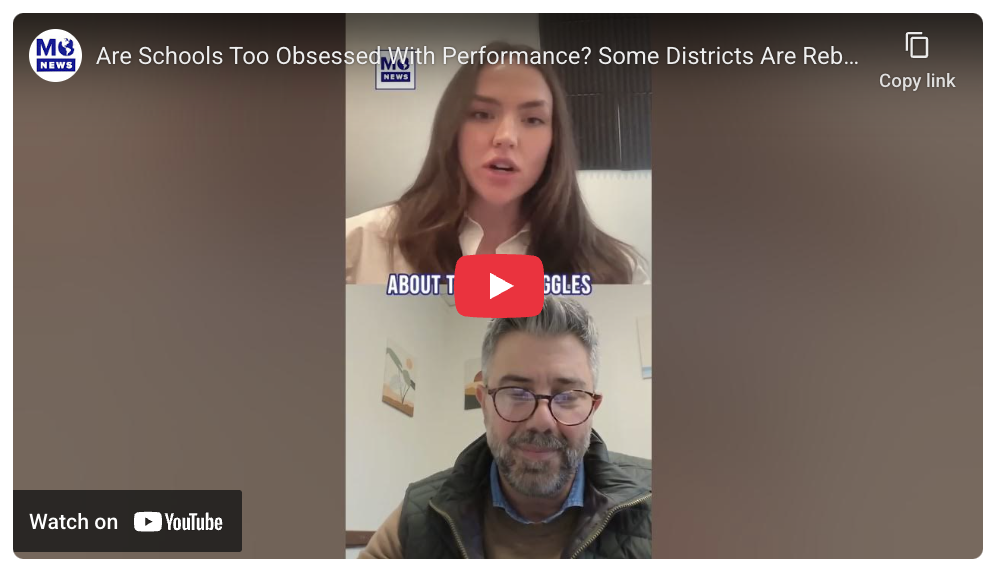'Targeted Shooting': Two National Guard Members Shot Near White House
Plus: Are Schools Making Kids' Mental Health, Attention Worse?
Happy (almost) Thanksgiving from all of us on the Mo News team! We are so grateful for all of YOU, and wanted to share a little joy for the holiday with Thanksgiving trivia 🦃
What percent of Americans prefer leftovers vs the original meal?
Before balloon, what did the Macy’s Thanksgiving Day Parade feature?
When did Adam Sandler release his infamous “Thanksgiving Song”?
Click the clip ⬆️ for the answers on the Mo News Podcast.
The Mo News Team
BLACK FRIDAY SALE! We are offering our best Mo News Premium sale of the year: Through Sunday, take 30% off all Annual Mo News Premium memberships with the code THANKS.
We’ll be off tomorrow, but back with a Black Friday Special edition. In the meantime, check out coverage on the Mo News Premium Instagram page.
🚨 ONE IMPORTANT THING WE’RE FOLLOWING
Two National Guardsmen Targeted By Gunman Near White House
Two West Virginia National Guard members were shot Wednesday afternoon near the White House. President Trump was at his Florida resort at the time of the shooting. Governor Patrick Morrisey said on social media the two had died, the backtracked, saying there were “conflicting reports.”
CNN reports that a gunman walked up and targeted the two guardsmen.
The police said a suspect is custody, who was shot and has non-life threatening injuries. Federal charges are expected to follow, and targeted political violence is often considered terrorism.
BIGGER PICTURE
More than 2,000 National Guard troops — from D.C. as well as West Virginia, Alabama, Louisiana, Mississippi, Ohio, South Carolina, and Georgia — have been deployed across the nation’s capital since Trump’s mobilization order in August. They’ve been patrolling Metro stations, tourist areas, and even picking up trash. Defense Sec. Pete Hegseth responded to the shooting, saying the administration will add 500 more troops to D.C. streets.
.🚨 ONE IMPORTANT THING
Are The Kids Alright? A Nuanced Look At The State Of Schools
A recent viral New York Times essay — “America’s Children Are Unwell. Are Schools Part of the Problem?” — sparked a huge response from our audience.
The article, by writer Jia Lynn Yang, argues that spikes in childhood mental health, ADHD, and autism diagnoses can’t be explained only by biology, screens, or parenting — it’s also deeply tied to how school has been redesigned into a high-pressure, metrics-obsessed system, forcing kids into a one-size-fits-all academic track.
Mo News Producer Lauren Janes sat down with Dr. Peter Faustino, the former president of the National Association of School Psychologists (NASP) and a school psychologist with nearly 30 years of experience, to unpack what’s really going on inside schools.
ALARMING NUMBERS
The article opens with some staggering stats:
Nearly 1 in 4 17-year-old boys has an ADHD diagnosis
1 in 13 children has an autism diagnosis
32% of teens have been diagnosed with anxiety
1 in 10 teens has had a major depressive episode
Faustino says the numbers confirm what many in schools already know: “There has been a long-standing crisis among our youth — even prior to the pandemic… [and] our concern has only risen.”
But he also notes that “If a child is struggling in school, it doesn’t necessarily equate to a disorder.” Instead, he focuses on gathering good information and thinking about how this makes a student unique.
“Making sure that we encourage parents and children to not see this as something they’re unable to do, but just something that they will have to work around — something that’s unique in their learning or development, but certainly not something that’s insurmountable in most cases,” he cautions.
ARE SCHOOLS DOING ENOUGH?
Since the pandemic, social-emotional curricula have become more common — 63% of public schools had a formal curriculum in 2023-24 — but are they doing enough? Faustino says schools should think in tiers:
Tier 1 – Universal: Lessons and supports for all students
Tier 2 – Targeted: Small-group or focused help for kids with emerging concerns
Tier 3 – Intensive: Highly individualized support for the most vulnerable students
What happens in districts that barely have enough counselors, let alone tiered interventions? That’s where advocacy comes in, Faustino explains.
Advocate relentlessly: “Parents, teachers, school psychologists, even children themselves need to advocate, knowing that there are really good resources and opportunities that exist in some communities but not in others,” he says, explaining that funding, trusted information, and the number of professionals will play a role in access to that.
During his year as president of the NASP, traveling around the country, he saw disparities in staffing, mental health support, and training. He notes that education is not monolithic: “Education and child development are much more complicated than you initially think. And we’ve really got to sort of work together to have these conversations about where our energy is best spent.”
“Equity is the word I am most fond of responding to when someone asks me what is wrong with education right now.” People, he argues, do not do more with less, but “end up doing less with less.”
THE POLITICS OF IT
The essay outlines how — across administrations — the government has moved toward standardized testing and high-stakes accountability. That comes with incentives for schools to hit performance benchmarks. In the day-to-day reality, that can look like less recess, more homework, endless test prep, and anxiety over college admissions.
Beginning in the late ’80s and ’90s, governors from both parties rolled out statewide standards and high-stakes testing.
“Schools were treated more like publicly traded companies, with test scores as proxies for profits,” Yang writes.
By 2002, No Child Left Behind made testing-and-accountability the law of the land. What it looked like: Schools faced punishments or rewards based on test scores, intensifying pressure on students and teachers.
Experts say the solution isn’t to swing to another extreme — it’s to rebalance.
One example: moving from short, rushed lunches to a common 45–60 minute lunch where everyone in the building eats and connects at the same time.
On the other hand, a growing unschooling movement — self-directed learning like homeschooling — has some families rejecting the school day structure. Faustino says he gets the appeal — it can look like a more personalized — but says that in his experience, many families eventually come back due to public schools’ resources.
HOW DO WE NAVIGATE THIS?
Relationships, Faustino argues, between parents and teachers, teachers and students, and across the broader school community.
“If there’s one piece of advice for restoring hope,” he says, “it’s to focus on the relationships in a school building, in a classroom, in a community. You’ll find more caring people than you realize.”
⏳ THE SPEED READ
🚨NATION
Kristi Noem made final call on deportation flights after judge ordered planes to turn back, DOJ says (NBC)
National Parks raising fees for international tourists visiting popular US parks (FOX)
ICE arrests woman with family connection to White House press secretary Karoline Leavitt (ABC)
Half of Americans approve of Democrats’ message on ‘illegal orders’: poll (THE HILL)
🌎 AROUND THE WORLD
Massive Hong Kong fire: death toll rises to 36, over 250 people still missing (MO NEWS/BBC)
Australian teenagers ask high court to block social media ban (NBC)
Greta Thunberg banned from Venice after Grand Canal dyed green by climate activists (ABC)
Israel begins West Bank operation amid settlement expansion (DW) as body of Dror Or, devoted father and Be’eri cheesemaker, returned to Israel from Gaza (TIMES OF ISRAEL)
Soldiers in Guinea-Bissau, a West African nation, announce their government takeover on state TV (AP)
📱BUSINESS, SCIENCE & TECH
Fewer Americans sought unemployment benefits last week as job cuts stay low (AP)
Campbell’s defends soup after executive calls it bioengineered ‘sh** for poor people’ (MO NEWS)
Black Friday is most popular with Gen Z, even as the holiday loses its shine, new survey finds (CNBC)
Scientists detect sounds of what they believe is lightning on Mars (NPR)
🎬 SPORTS & ENTERTAINMENT
Apple TV pulls thriller ‘The Hunt’ after claims it plagiarized 1973 book (THE TELEGRAPH)
Missing Virginia high school football coach labeled ‘fugitive’ as local community alleges long-known accusations (FOX)
‘Food Network’ star Guy Fieri now wheelchair-bound after he fell down stairs on set (NBC)
Warner Music settles legal war with AI music generation platform Suno in landmark AI partnership (HOLLYWOOD REPORTER)
ICYMI FROM THE 📲
In case you missed it… Robert Irwin, son of the late Australian crocodile hunter Steve Irwin, took home the grand prize on season 34 of Dancing With the Stars alongside pro dancer Witney Carson on Wednesday.
The 21-year-old conservationist has made a name for himself over the past few years as a TV personality, nature photographer, and wildlife advocate. His win comes a decade after his sister, Bindi Irwin, also took home the show’s top Mirrorball Trophy.






